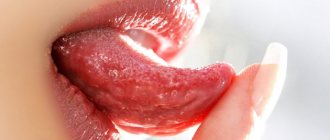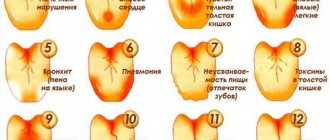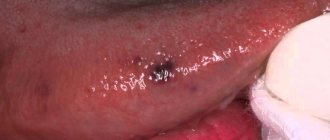A clean pink tongue is an indicator of good human health.
The appearance of an unpleasant odor, a change in the shape of the tongue, the presence of spots and grooves, or the formation of plaque on the tongue indicates the presence of certain health problems. If you have a coating on your tongue, this can be a serious “bell” that indicates health problems. Come to the dentist for an appointment, he will conduct an initial examination, collect anamnesis and perform a correct diagnosis, which will determine what plaque on the tongue indicates in your case, as well as the severity of the problem.
Plaque on the tongue in adults, adolescents and children is often caused by the following factors:
- Insufficient or absent hygiene - observed in people who neglect the rules of oral hygiene or perform it only partially, for example, they brush their teeth only in the morning, brushing their teeth takes a couple of tens of seconds or do not pay attention to cleaning the tongue;
- Hormonal changes are a common cause of the formation of plaque on the tongue during puberty, during pregnancy, menopause, etc.;
- Pathological changes in internal organs - plaque is a pronounced symptom of a whole complex of diseases of internal organs, directly or indirectly related to digestion or the production of hormones.
There are dozens of other, less common causes/factors that can cause a coated tongue with or without an odor. The exact cause can only be determined by the attending physician based on the medical history, initial examination and diagnostic examination.
Other reasons
If a white coating appears on the tip of the tongue, this indicates inflammation of the bronchial tubes. But the location at the base and on the sides can warn of renal failure. This is a very serious diagnosis that needs to be given the highest attention.
Other symptoms of this most dangerous disease are an unpleasant odor and dry mouth, constant fatigue, and weakness. Such patients cannot withstand even slight physical exertion. If these symptoms occur, you should consult a nephrologist.
A rough tongue can also occur in diabetes. It is knitted, and a dense gray coating is visible on it. It is located in the center. These symptoms are explained by the fact that diabetes may impair the function of the glands located under the jaw. They produce less saliva and the following symptoms appear.
If a white coating appears on the tip of the tongue, this indicates inflammation of the bronchial tubes.
With glossitis, the white plaque is accompanied by a burning sensation, pain and loss of taste.
With anemia, red spots form on the tongue, around which a white coating is visible. This is due to the process of atrophy.
Note! A dense white coating can warn that a malignant neoplasm has appeared in the gastrointestinal tract.
As you can see, the reasons can be very serious. If the plaque is not removed after cleaning and other symptoms are added to it, the tongue has become rough, it is better to consult a doctor about this problem.
Types of plaque on the tongue
Doctors identify seven main types of plaque, which we will discuss below. Both a strong coating on the tongue and a barely noticeable one can appear. The intensity of its manifestation indicates the complexity of the problem and the stage of its development. Let's consider all types in more detail:
- A pronounced white coating is a sign of active bacterial growth, which may indicate problems with the gastrointestinal tract. Particular attention must be paid to the localization of plaque. If the read part is located near the root of the tongue, this indicates a digestive disorder. The presence of a thick layer of white plaque with an unpleasant odor may indicate an infectious infection of the body or a complete blockage of the stomach;
- Yellow/orange plaque – characteristic of people suffering from liver dysfunction. It can also manifest itself in the early stages of the development of jaundice, gastritis, due to an excess of bile, as well as problems of the genitourinary system;
- Brown plaque is often accompanied by the appearance of a rather viscous substrate on the tongue. It is observed in people suffering from progressive candidiasis, gastritis, and Addison's disease. May manifest itself in stomach ulcers, dysbacteriosis and cholecystitis;
- Gray plaque is often accompanied by the formation of deep cracks in the mucous membrane of the tongue and its peeling. Most often it appears due to uncontrolled use of antibiotics or hormonal drugs, with electrolyte imbalance in the body and a number of dental problems, including stomatitis;
- Green plaque - may be accompanied by a pronounced putrefactive odor. It is a sign of serious disturbances in the functioning of the digestive system, the development of fungi, vitamin deficiency, a decrease in the immune system and a consequence of the immunodeficiency virus;
- Black plaque has a pronounced gender predisposition. In 70% of cases it is observed in men, 30% in women. May be accompanied by the formation of ulcerations and bitterness in the mouth. Speaks of an imbalance in the acid balance in the body, it can be caused by chronic intoxication (for example, as a result of occupational diseases), stomach ulcers, fungal infections or chemical poisoning;
- Violet is not a specific coating; it manifests itself in acute disorders of cardiac activity and the functioning of the circulatory system. It is a shade of blue in the mucous membrane of the tongue, visible under a whitish coating.
Answering why plaque appears on the tongue, it is worth noting that plaque is a consequence of one or a whole complex of factors caused by a violation of the normal state of the body.
Xerostomia: causes
As a rule, the causes of xerostomia are “hidden” not in the salivary glands themselves, but in a disease of any system of the body or a general infectious disease. This condition is mainly caused by:
- Infectious diseases: tonsillitis, tuberculosis, HIV, tonsillitis, mumps (aka “mumps”, an infectious disease of the parotid salivary glands).
- Hypertension or severe iron deficiency anemia.
- Rheumatoid arthritis, as well as some diseases of the endocrine system: thyrotoxicosis (occurs when the thyroid gland is damaged), diabetes mellitus (develops when the function of the pancreas is impaired), sialadenitis (inflammation of the salivary glands themselves).
- Head or neck injuries, constant mouth breathing due to injury to the nose or the formation of polyps in the sinuses.
- Long-term use of certain groups of medications, dehydration with prolonged fever or vomiting.
- Bad habits: drinking alcohol, smoking, drug use.
The functions of the salivary glands are not necessarily impaired in all of these diseases and conditions, but if a person has xerostomia, they will be considered as possible causes.
Methods for diagnosing plaque on the tongue
Despite the active development of medicine and dentistry, in particular, today there are no specific methods for diagnosing plaque on the tongue. The diagnosis is made on the basis of comprehensive measures aimed at collecting anamnesis, visual examination of the patient’s oral cavity and targeted diagnosis by specialized specialists.
In the process of visual examination, first of all, the doctor uses the organoleptic method. He pays attention to the shade of plaque, the mobility of the tongue, the thickness and localization of the substrate, as well as its smell - these indicators say a lot about the root cause of the problem.
After the initial examination, if there are grounds, the doctor may send the patient for additional diagnostics, which may include a number of high-precision diagnostic methods, including: a comprehensive blood and urine test, coprogram, ultrasound of the digestive organs, esophagogastroduodenoscopy and some others.
How to remove plaque from your tongue
To remove plaque, it is enough to carry out hygienic cleaning of the oral cavity with careful treatment of the mucous membrane of the tongue. In the vast majority of cases, this method provides only a temporary effect, which can last from several tens of minutes to several hours. But after a certain time, the plaque appears again, bringing a person discomfort and a lot of inconvenience.
In order for the effect to last longer or not to appear in the future, it is necessary to determine the root cause of why the plaque appeared on the tongue - this can only be done with the help of a qualified doctor, who must carry out an effective diagnosis of the problem. The doctor will also advise you on how to get rid of plaque on the tongue with maximum efficiency, and will also write out a detailed diagram of how to treat plaque on the tongue in a particular case.
Treatment
If the tongue is uneven, you need to fight the underlying disease. The doctor makes a diagnosis and prescribes comprehensive treatment. To alleviate the condition, rinsing with antiseptic solutions may be prescribed locally. Creams and ointments are also prescribed. They relieve pain, inflammation, and accelerate healing. At home, treatment boils down to cleaning, rinsing, and applying ointments.
A rough tongue and plaque on it are symptoms of a number of diseases. Only a doctor can accurately determine the cause in a particular case. Even he will need to diagnose and prescribe a series of tests for the patient. But self-medication can lead the disease to an advanced form. Then it will be much more difficult to overcome it.
How to remove plaque from the tongue: techniques and treatments
Plaque cleaning is carried out in the classic hygienic way. The process can use the reverse (rough) side of a toothbrush or a special dental scraper.
The cleaning procedure is carried out in several stages:
- Place the toothbrush with the rough side facing your tongue;
- Apply toothpaste to the surface of the brush;
- Place the brush on the root of the tongue and clean off deposits with smooth movements;
- Rinse your mouth with running water.
This procedure is very effective for eliminating the natural whitish bacterial plaque that appears in most healthy people during sleep or during the working day, but to eliminate a specific “colored” plaque, you need to use special products: Miramistin (an antimicrobial/antiviral agent for green plaque ), peach oil (for yellow plaque), chlorophyllipt (for brown plaque), resorcinol 5% (for black plaque), hexetidine (for gray plaque).
It is worth understanding that the problem of “colored” plaque can be completely eliminated only after the underlying disease has been completely cured.
Infections
Another reason is infections. The microflora in the mouth is quite rich. Along with beneficial bacteria, it also contains pathogenic microflora. It is this that can cause unevenness on the surface of the tongue and a white coating. Very often, such manifestations are observed when infected with Candida fungus. It is present in the body of each of us.
The surface of the tongue may change with sore throat.
With normal immunity, this fungus is contained and does not multiply. But a weakened immune system does not cope well with it. This disease is popularly called thrush, and in medicine it is candidiasis. In this case, the oral mucosa and tongue are affected. A characteristic feature is a cheesy coating.
Sore throat also provokes plaque. This is due to the fact that staphylococci and streptococci enter the mucous membrane. Patients suffer from fever, pain and burning in the throat. If it is tonsillitis, then a yellow coating forms at the base of the tongue and on the tonsils.
Another pathology is leukoplakia. It can be confused with thrush. A distinctive symptom is keratinization of the mucous membrane, burning, red and white spots. They are located on the sides and top of the tongue. If you have such symptoms, you should consult a doctor. Leukoplakia can cause malignant tumors.
Roughness is only a symptom; the underlying disease needs to be treated.
Note! Most often, a rough tongue is observed with stomatitis. It all starts with swelling of the gums and tongue. They turn red and then become covered with a white or red coating. The tongue becomes rough, and small but very painful ulcers may later appear on it. In order not to wait for their appearance, it is better to start treatment immediately.
Prevention of plaque on the tongue
Prevention of plaque on the tongue is non-specific and fits into the rules of daily hygienic oral care:
- Daily brushing of teeth – 2 times a day (morning and evening);
- Using dental floss after meals and mouthwashes;
- Regular visits to the dentist - at least 2 times a year for a preventive examination;
- Timely treatment of digestive problems and pathologies of internal organs.
Have you found a coating on your tongue and don’t know how to get rid of it? Make an appointment with our specialist and he will provide the necessary assistance!










